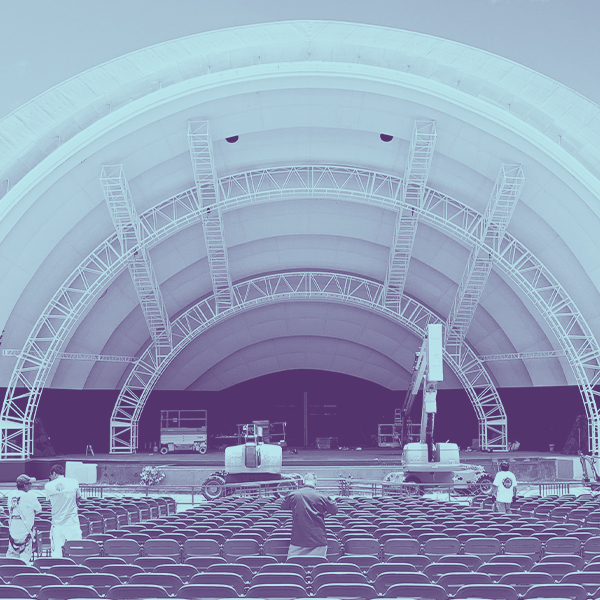“There’s a storm movin’ in… and the thunder rolls…”
Imagine you’re halfway through the set of Garth Brooks’ latest outdoor show. The beer is cold, the crowd is rocking, the vibe is strong and you hear the rumble of thunder. Thoughts run through your mind. Are my windows closed? Did I wear the right shoes for rain? Will he play “Friends in Low Places” next? Is this venue prepared for situations related to storm management?
Okay, probably not that last one, but the good news is, that last question has been considered by those responsible for the event. Like the weather, the ability to predict the unknown is paramount in event management. This requires collaboration from all involved, specifically venue management, production, the artist and the designer. While they can’t predict everything, preparing for the worst, like weather, crowd surges or medical emergencies is essential for a successful event.
Outdoor event venues
Indoor venues follow traditional building codes for the area where it’s located. This blog gives a structural engineer’s perspective on outdoor event venues. There are two types of venues which may or may not be in your hometown.
Temporary venues
Did you know there are 800+ music festivals every year? These types of events are where you’re most likely to encounter temporary structures, most often as roof structures covering stages. These structures also have to set up + break down in a matter of days, ready to move to the next stop on the tour.
The structural design of these temporary structures is not specifically defined in the building code, and standards in the industry, such as ANSI ES1.19-2020 and ANSI/ESTA E1.21 attempt to provide some guidance on their design, specifically as it relates to wind. The good news is that proposed changes to the language of the 2024 International Building Code are underway and include structural provisions to account for the temporary nature of these structures as it applies to lateral loads and wind criteria. Emergency management plans and high wind actions plans become a critical part of the performance of these structures.
Permanent outdoor venues
These are generally outdoor amphitheaters. The stage + back of house areas generally have permanent roof structures. The seating areas may or may not be covered, but they are not entirely enclosed.
Here in Cincinnati, Ohio, one of our most popular concert venues is Riverbend Music Center. Riverbend is an outdoor amphitheater with two types of seating – some that is covered and some lawn seats which are, you guessed it, a stretch of exposed artificial turf behind the covered seats. The permanent structure is a roof with open air sides and designed according with Ohio Building Code for entertainment structures. Permanent venues are designed to withstand building code forces, and upwards of 115 mph in the Midwest, as these structures are expected to withstand a higher standard for storms than can occur throughout its lifetime. Along the coastlines, the probability of a major wind event increases, and these permanent structures must withstand upwards of 180 mph winds. However, despite the structure’s ability to withstand this storm, patrons and the entertainment would not be around an outdoor venue such as this in these extreme weather conditions, but the structure will remain.
Outdoor venue storm management
Regardless of weather forecasts, the structural engineering designer collaborates with vendors so that the stage and other elements at the event have been designed for high winds + severe storms. Extreme weather can occur at any time, so structures that can withstand the forces associated with intense winds is critical for maintaining a sense of calm amongst the event staff + audience. A swaying stage or unstable structure should not happen and would rightly so lead to panic amongst the crowd.
Most temporary concerts + festivals occur over a weekend or, for longer events, a week. As you can imagine, the probability of a storm is likely dependent on the time of year + location, but it’s not all doom + gloom – don’t forget that there’s also the probability that it will be sunny + clear for the entire event!
For permanent structures, the design wind speeds (say 115 mph in the Midwest) are based on a statistical analysis of wind speeds occurring over a 50-year period. When was the last time you where at a concert in a 115 mph storm? Probably never. You were able to relocate to a safer location, and/or the concert was probably stopped + evacuated before the storm picked up. And that’s for permanent structures – walking around at an outdoor + temporary event in even 40 mph winds can be a little unsettling.
So, what do we do? Unlike for an event within a permanent structure, outdoor + temporary event management is required to actively monitor the weather, and if a weather event is imminent, certain actions can be taken.
- Stage personnel can lower backdrops that would decrease the wind force on the structure and leave an open structure for wind.
- In some instances, the entire venue could be shut down and people evacuated to more permanent structures designed for higher wind speeds.
- A planned strategy to evacuate early with proper egress paths could allow the thousands of people in attendance to calmly evacuate vs. stampeding out of the venue.
- Plan ahead: if the event is for a week on an east coast beach and a hurricane is gaining strength in the Caribbean, the entire event can be packed up or not even set up.
By balancing the code defined wind design force for permanent buildings and applying a lower probably of these events in temporary structures, the industry can provide a safe structure that still performs with lower standards. And if this once in 50-year event happens during the show, the administrative procedures of evacuation or cancelling the event can happen, eliminating loss of life. However, the structure may not survive this major storm event – an exception this industry may take.
Those of you recently at the We Were Young Festival have first-hand experience of this mitigation effort. On Saturday, wind gusts approached 60 mph with sustained winds around 40 mph, knocking over trees and kicking up sand in the Las Vegas desert. Unfortunately, your show was cancelled on Saturday. However, the next day, after checking the structure for damage due to wind, the concert continued and patrons were able to attend the show. Unfortunately, it’s a risk that patron takes when heading out to a large temporary event
So, why not design these structures for the full design winds that a permanent structure must withstand? Obviously, the cost of the structure would dramatically increase (if we were asked to design for hurricane force winds, there wouldn’t be any events along the coast). The expense is not only in a bigger structure, but now the cost of transporting said structure, lifting with heavier cranes and additional set up time that would most likely reduce the number of events that would occur. If you think concert tickets are expensive now, the price would inherently increase.
We’re not advocating cutting corners in the design of these structures. We’re advocating for a rational approach to designing safe structures using administrative controls and probability of a major event happening during a three-day event. The standards + codes that continue to develop take these measures into account for design of these very different structures. It would not make sense to design a three-day structure for a 115-mph wind speed, when there wouldn’t even be a show at during a weather even with 40-50 mph winds. I encourage you to take a stroll through your neighborhood during this type of wind event, and ask yourself if, at a concert you would be willing to continue to watch.
Event management has evolved over the past 10-20 years. Even 20 years ago, events + structures may have typically been erected without a structural engineer, or without any planning at all. Obviously, the evolution of events, combined with increased attendance for entertainment post-COVID, and lack of experienced personnel to handle the influx continues to drive a need for even more planning, more written down standards. Monitoring wind speed on stages and technology to predict oncoming wind events have advanced. Standards developed by ESTA and the Event Safety Alliance just in the past 4-5 years have been written and continue to evolve. For instance, a document built out of a need to provide guidance to design these structures, ESTA/ANSI E1.21, that has been used since the early 2000s was the impetus for new proposed model building code changes in 2024. Safety of those in attendance is continually being discussed amongst professionals, from egress paths being established in large crowds, and for security personnel and screening becoming more of the standard at events. You even see the performer getting involved when they see people in distress in the crowds.
Outdoor venue crowd management
Managing the venue begins long before any tickets are sold or artists are announced. Production staff and key planners meet at the venue to review crowd capacity, exit plans, site setup, and other logistics essential to keeping a roaring crowd from overrunning the stage, or maintain separation between back of house production and a fervent throng of groupies. Setting up the event requires coordination with the local jurisdiction, including police, fire, EMTs and other first responders to verify the plan matches their best practices for a positive event in that locale. Good planning is a continuous process, resulting in outcomes that are equitable for both production + event safety.
Collaborating with the artist is vital. The artist understanding the maximum crowd size, weather indicators and triggers for event management are musts. Working with local staff to calm a crowd or pause a set if needed are crucial, but still need to be addressed early in planning and reminded the day of the event to safeguard positive outcomes. “The show must go on” is often the exact opposite of what’s important for crowd safety.
Outdoor venue safety
It’s not just inclement weather that needs a plan. While the main stage brings the most eyes, there are often a variety of other structures necessary for a successful event.
- A hot, sunny day can be dangerous as well. Shade structures + water opportunities are necessary for full-day or multi-day events in hot climates. Have a show in the middle of a desert or field with the closest permanent facilities 30 minutes away? This must be considered.
- That standalone structure advertising the newest hard seltzer to hit the market isn’t just marketing – it’s a landmark for groups that get separated.
- Since many of these concerts are on fairgrounds or undeveloped sites, bringing in lighting is a requirement. Lighting also has a structural component, in need of ballast and a plan for severe weather. These large lighting towers, sometimes 40 ft tall to better broadcast light, must be able to withstand large wind forces, as they cannot be taken down, and the concrete ballast, guy wires, and small connectors must be sized + installed appropriately. One defective break in the chain could cause failure.
- Sobriety checkpoints + parking layout may or may not require structural attention, but help keep attendees and the local community safe, and are a concern for event management staff.
- The amount of facilities, restrooms, showers, etc. for the size of crowd needs to be considered.
Future of outdoor event management
Event protocols can be planned to the best possible standards, but still can be improved and rely on all the people understanding and executing the plan when events do not go as expected. Better means of egress, communication from the artist or production, and evacuation checkpoints are all items that are being reviewed amongst professionals to improve the event experience if the worst happens.
All parties play an important role in creating a safe + enjoyable experience. Hopefully your next show is perfect weather with zero headaches between arrival + departure, but if it isn’t, know that someone along the way has thought of contingencies to make sure you want to come back for the next one.
Resources
Planning an event of any magnitude is certainly not one size fits all, but there are guides, codes + industry standards that play an important role in the execution of every show. One of the first standards published was the “Purple Guide to Health, Safety, and Welfare at Music and Other Events.” The book covers everything from legislation to worker safety, weather, and sanitation. Many of the documents published in the United States have a basis in the Purple Guide.
The Event Safety Alliance has published “The Event Safety Guide: A Guide to Health, Safety, and Welfare at Live Entertainment Events in the United States.” ESTA (Entertainment Services and Technology Association) has led the charge in putting together many of the ANSI standards that provide a basis for live entertainment rules and guidelines, specifically, ES1.7, “Event Safety: Weather Preparedness”, ES1.9, “Event Safety-Crowd Management”, and ANSI E1.21, “Entertainment Technology: Temporary Structures Used for Technical Production of Outdoor Entertainment Events.” With working groups continually updating standards, ESTA and the Event Safety Alliance have provided guidance for each of the parties to form a specific safety and management plan for each show.




